
A social media crash course will teach you everything you need to know about Facebook, Twitter LinkedIn and Instagram. This course covers how to create a Facebook Business Page and manage your company's presence. After completing the crash course, you will be able navigate these platforms confidently. Workshops are a great option for those who are new to the world of social media and want to make a better impression. These workshops are delivered via webinar. Participants can view the Zoom Q&A feature and ask questions with their muted cameras.
Facebook Business Page
Registering for a Facebook Blueprint is a great idea if you don't have one yet. This enormous collection of free social media classes offers an in-depth view at the best practices, strategies, and strategies used worldwide by the largest brands. Facebook is quickly becoming a platform that charges a fee to advertise on it.
Instagram
If you are interested in growing your Instagram audience and making money from it, you are not alone. This course will help you learn practical strategies, methods and tips to increase your audience, gain new followers and make more money using Instagram. Sorin Constantin, a network marketer and professional who has studied two network marketing companies and sold more than $500k worth of products, developed it. Sorin Constantin has extensive network marketing and social media experience. He also has the expertise to create successful online businesses.

Twitter
Twitter may seem intimidating to new users. A Twitter crash course can be the answer to this question. You can jump right into part one of the course, which is composed of five parts. Twitter can be reached directly for more information. These are some of the advantages of enrolling in the course. You will learn how Twitter works and the tools it offers. A Twitter crashcourse can help you increase your following and boost your online business.
LinkedIn
These tips will help you maximize LinkedIn's potential. Post regularly and in a consistent manner - companies that post weekly experience a 2x increase in engagement. Use images and videos when posting - they generate five times more clicks than regular posts. Use 9am to 5pm to post - LinkedIn members are most active between these hours. Tuesdays between 11am and 12pm are the most visited.
YouTube
A YouTube social media crash course may be a good idea for those who have just started a YouTube channel but are having trouble getting viewers. YouTube offers lots of great content, and people share their experiences with other users. It is important to understand how to draw and keep your viewers. This course will provide you with the foundations of social media marketing. It will also teach you how to build your own fanbase. Regardless of the type of content you create, there are several tips that you can use to make your videos more interesting to watch.

LinkedIn Business Page
If you aren't sure what to put on your LinkedIn business page, here are some helpful tips. First, ensure that your company's profile has been properly indexed by Google. All information should be included. Try to use natural-sounding words. Your company name, contact information and a cover photo of high quality should be included. Optimized keywords should be included in the overview section. People will visit pages with more information.
FAQ
How much does content marketing cost?
The price of content marketing varies depending on whether you're looking for an outsourced solution or you're going to handle everything yourself. Outsourcing content marketing services are usually cheaper than hiring full-time employees, allowing you to scale quickly when you need more coverage.
HubSpot research has shown that outsourcing content production costs $5 per lead for B2B companies, compared to $22 for consumer brands.
There are many web resources that offer free content marketing tools, which you can use to create compelling content that converts.
There are many ways you can optimize content to be found on search engines like Google and Bing. For example, you can write original articles, guest post on blogs, curate content from other websites, and repurpose existing materials.
You will need to know how to create great content if you decide to go the self-produced content route. It's easy to create content once you have it down.
First, create simple landing page using WordPress. Next, start building your site. This way, you can build a portfolio over time.
Do I need to hire a writer for my Content Marketing?
No! To produce content for your business, you don't necessarily need to hire a professional author. There are tons of free resources out there that can help you get started.
Is content marketing simple to measure?
Yes! It's part of the process. This helps you to determine if your efforts were successful or if you need to make adjustments.
It is possible to track the number of visitors from different sources, including organic search, email and social media. You can also track conversions such as sales leads or purchases.
These metrics allow you to see which content is performing well and where your greatest opportunities are.
What's the difference among content creation and marketing?
Content marketing is a way to ensure that every brand has the same message. They consistently deliver the valuable information people want and require.
Content marketers understand how to create the best content for each channel at various times.
They also have the ability to devise a plan for distribution and promotion.
They think strategically about their actions and the reasons they do them.
This is the core skill set needed to be a successful content marketer.
Statistics
- This marketing strategy landed Ford a 15.4% conversion rate. (neilpatel.com)
- To further show the importance of this, 89% of people have stopped doing business with a company because of a poor experience. (neilpatel.com)
- Companies that use content marketing see approximately 30% higher growth rates than businesses not using it. (mailchimp.com)
- According to the Content Marketing Institute, 70% of B2B marketers and 86% of B2C marketers surveyed use content marketing in some form or other. (criteo.com)
- According to our research, 65% of companies with very successful content marketing in 2021 ran content audits at least twice a year. (semrush.com)
- Out of the 1,500 marketers we surveyed for our State of Content Marketing report, 78% who felt their content marketing strategy was exceptionally effective in 2021 had documented their strategy. (semrush.com)
- An example of an overarching goal could be: "In 2022, we want to achieve a 20% increase in revenue created by organic content and generate 15,000 MQLs with a budget of $30,000." (semrush.com)
- According to research compiled by Coschedule: Companies that publish 16+ blog posts a month get as much as 3.5x as much traffic as those that publish 0-4 posts a month. (criteo.com)
External Links
How To
Informationgraphic creation tips to help with content marketing
Infographics are a powerful way to simplify complicated concepts, and make information easier to understand. Use infographics as a tool to promote your content marketing message.
To create an infographic, Adobe Illustrator or Photoshop is required. You can use these programs to draw out different shapes and elements to represent your data, then add colors and fonts to make everything look nice. Once you are happy with your design, you can upload images to Unsplash and Pixabay for your design.
Looking at other infographics online can help you get ideas. For example, if you want to show how many calories are in certain foods, you could take a picture of a food pyramid and replace the numbers with pictures of those foods. You could also look at the sugar content of soda pop, and then take a photo of a Coke bottle.
Once you've created your infographic, share it on social media channels like Facebook or Twitter. This allows people who don’t know much about the topic to find out more. Include hashtags if you plan to share your infographic via social media platforms. This will allow others to see what you're talking. Hashtags allow users to follow along with conversations surrounding specific topics.
If you decide to create an infographic, try making your posts shorter than usual. An average blog post is between 2000 and 5000 words, while an infographic takes 500 to 1000 words. This means you can easily convey more information with less space.
Remember that not all viewers can read small font sizes when designing an infographic. Your graphics should be large enough in font size and not rely on too much color. Make sure all text is legible.
Here are some additional tips :
-
Choose an Infographic Template. There are many free templates available online and in printable formats. Canva, Piktochart and Google Slides are the most used templates.
-
Create your Infographic. Create your infographic using the template. You can use any kind of media that you feel is appropriate for your audience. If you want to create an infographic on the best places for food in Seattle, for example, you might use photos from local restaurants.
-
Add Text. Once you've created your infographic, add text using Microsoft Word, PowerPoint, or Canva.
-
Add Images. Your infographic can also include images. These images can include charts, graphs and icons. Make sure your picture is relevant to the topic you are adding.
-
Make It Interactive. Interactive elements like buttons, maps and links can be added to your website. This will increase engagement with your audience.
-
Share. When you're done, share your infographic on social media sites like Facebook, Twitter, LinkedIn, Pinterest, and Instagram.
-
Measure. Do you know how well your infographic performed? Did people click on your website? Did they sign up for your email list? Was their reaction to the infographic?
-
Improve. Are there ways you could improve your infographic? Is there anything you could do better?
-
Repeat. Repeat.